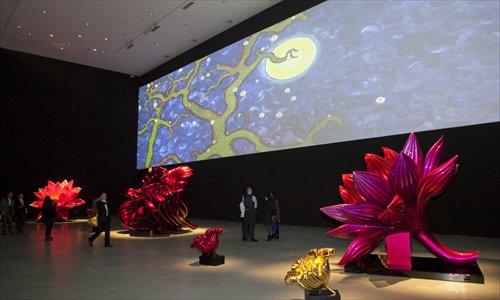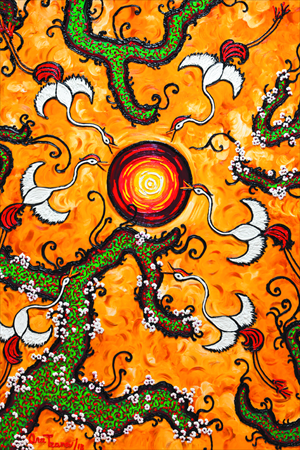Flower power
By Lu Qianwen Source:Global Times Published: 2014-2-6 20:28:01

Ana Tzarev's exhibition Wonderland at the Today Art Museum in Beijing Photo: Courtesy of Today Art Museum

Painting Wonderland Dance by Ana Tzarev Photo: Courtesy of Today Art Museum
Chinese art collectors have invested largely in local artists over the past several years, leaving those from other countries, despite world renown or innovative achievements, largely overlooked.This, however, is beginning to change. Local art museums are now making concerted efforts to tap into the exotic appeal of foreign artists, a move representative of the increased integration of artistic style, culture and markets worldwide.
This evolution is one of the many subjects of Ana Tzarev's Wonderland at the Today Art Museum in Beijing until February 25. The exhibition showcases 58 oil paintings and 10 sculptures, her largest undertaking in the Chinese mainland.
The museum's first exhibition of the year presents a floral dreamscape, as flowers, butterflies and cranes splashed in vibrant colors create an immersive experience for visitors. "I devoted all of my creative energy to designing a show that is far from a collection of works," Tzarev wrote in an e-mail to the Global Times.
Culture in bloom
Works by the 77-year-old Croatian-born artist have been shown at London's Saatchi Gallery and The State Hermitage Museum in St. Petersburg, while installations of her famed flower sculptures can be found in major cities around the world.
Tzarev attributes her global success to the vast travels of her youth. "I have been able to travel all over the world, see how others live and how they celebrate life," said Tzarev.
"There is a distinct energy to every culture, fantastic and singular, it is the spirit that keeps their practices and traditions alive. I try to carry pieces of that energy with me as I move through life, letting it enrich my perspective and in turn, my art," she added.
Though inspired by her diverse travels, flowers remain a consistent theme in her works. Wonderland features two paintings of large lotuses in bold color that impress immediately. Tzarev explains her floral fixation stems from the universal symbolism of flowers.
"They are beacons of positivity, bearers of goodwill that blanket our earth with brilliance. There is little else that immediately stirs that feeling of elevation in the soul," she explained.
Different strokes
Tzarev has bounced between her two studios in Monaco and Thailand for over 20 years, absorbing new experiences and exotic aesthetics into her work. Her interest in Asian art has produced two exhibitions in China. Tzarev debuted in 2012 with her show Magic at the Shenzhen Bay Sports Center and followed up with Exposed at the Hong Kong Arts Center the following year.
The warm reception from locals gave Tzarev the confidence to hold Wonderland in China, her largest exhibition to date.
"The response to Magic was truly touching. It showed me that art and flowers really do speak a universal language that people from everywhere can appreciate," Tzarev said.
However, her interest in China goes beyond the galleries. Tzarev draws inspiration and technique from the works of ancient Chinese masters, such as famed painters Qiu Ying (1494-1552) and Zhang Zeduan (1085-1145), the artist behind the enormous landscape masterpiece Riverside Scene of the Qingming Festival.
"I was enamored with how their works make such dazzling use of space and the fine details they contain," she said. "As time went on, I gained an appreciation of traditional Chinese textiles as well."
The latter partly explains her use of complex and layered textures that makes her subjects pop with a three-dimensional effect.
Several works in Wonderland also feature traditional Chinese elements such as cranes, lotuses and lilies. These themes, according to the artist, were specifically added with local visitors in mind. "I am captivated and moved by so much Chinese art. The cranes and blossoming trees were inspired by this country's rich artistic history," said Tzarev.
Blurred lines
"Flowers have always been favored by Chinese artists," said Peng Feng, a local art critic. "As a product of nature, flowers transcend the boundaries of culture with their beauty. The large-scale use of flowers in Tzarev's works underscores the approaching of a new culture generated by the era of globalization," said Peng.
While markets for fine art vary in different regions, past distinctions between Western and Eastern art are fading and artists are integrating different traditions into their works.
Just as visitors can trace Chinese elements in many of Tzarev's paintings, the vibrancy and strong emotions she delivers can also be found in many contemporary Chinese artists' works. Particularly, the glitzy firework pieces of the New York-based Cai Guoqiang, who Tzarev says is not afraid to reinterpret tradition.
"Much of China's contemporary art facilitates the exchange of ideas across borders, contributing to a new art world that is defined by its diversity, not its divides," Tzarev emphasized.
Posted in: ARTS